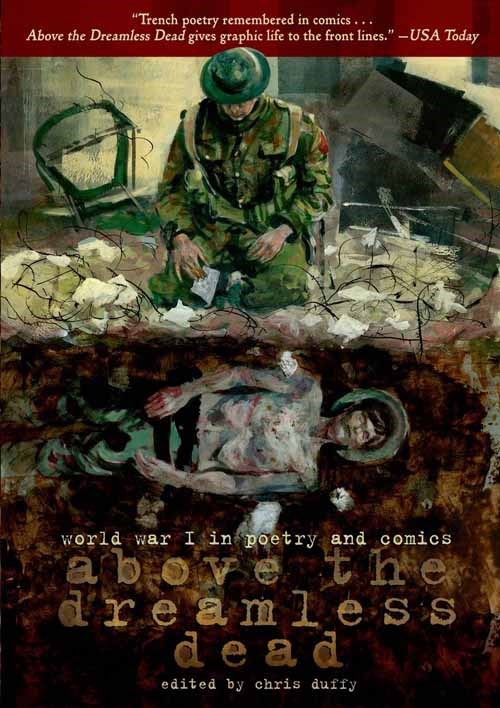There are books that when you see them online, or in a bookstore, and before you even crack the cover you know it is likely to something special.
Such was the case with 'Above the Dreamless Dead'.
The book brings together poetry from the First World War together with some outstanding comic book artists, and the result is powerful to say the least.
The strength lies initially in the words, and that should not come as a surprise since the poems come from soldiers themselves.
"As the Great War dragged on and its catastrophic death toll mounted, poets turned their pens to a world upside down. Many of the Trench Poets, as they came to be called, were soldier-poets dispatching their verse from the front lines. Known for their impassioned portrayals of life and death on the Western Front, these poems became, for much of the world, the literary heart of the Great War," details the book dust jacket.
It is amazing how powerful the words are. It's not that every poem drips with visions of battles. Often the poetry comes from very different emotions than one might expect, and therein lies the great insight of the poetry.
Again from the dust jacket "'In Above the Dreamless Dead', the words of the Trench Poets find dramatic expression and reinterpretation in the hands of some of the greatest cartoonists working today. This daring marriage of poetry and comics, edited by New York Times - bestselling editor Chris Duffy, is a moving and illuminating tribute to those who fought and died in World War I."
So a bit more on Trench Poets is important to understand the power of the book.
"The English soldier-poets of World War I are known collectively as the Trench Poets. Wilfred Owen is the most famous of these, arguably followed by Siegfried Sassoon and Isaac Rosenberg. The Trench Poets are often thought of as a group, but that's more or less a fiction created in the years after the war, as people tried to make sense of the huge conflict. Some of the Trench Poets were friends, but on the whole, they came from many classes, had different educational backgrounds, wrote in a variety of styles, and held different religious and political beliefs," details the book's introduction.
"What the Trench Poets did have in common was their subject and their setting; the war's Western Front. This consisted of almost unmoving lines of trenches that stretched nearly 500 miles across Belgium and northern France from autumn 1914 to spring 1918. Trench warfare has become nearly synonymous with World War I, and it's what comes to mind when almost anyone thinks of that war. It's worth reviewing though.
"Machine guns and artillery made rapid advances of troops on land impossible for most of the war. In the conflict's first year, the German Empire's forces and the Allied troops found themselves dug in, facing each other from trenches that were from 100 to 600 yards apart. Trenches were usually 10 feet deep, with sand bags in front and behind raising the walls even higher. The front line of trenches connected to two lines of trenches behind them - one for support troops, the other for reserves. The men in the trenches could experience constant shelling and sniper attacks, depending on their location, and shell shock (now known as post-traumatic stress disorder) was common. Flooding, disease, and pestilence (in the form of rats, lice, mites, frogs and slugs) were constant problems. Corpses were often left unburied for weeks, as any activity could invite attacks from the enemy line.
"Life in the trenches was legendarily miserable. The narrative of that misery has been challenged in recent decades by some writers and historians who want us to know that the Western Front wasn't a setting of nonstop terror and disease, It's telling, though, what "comforting" facts these writers cite: that there were actual dressing stations nearby to treat the sick and wounded; that the average soldier only spent 55 per cent of his time in the trenches; that only one in 10 soldiers died on the front."
Alone, the poetry would be a unique look inside the war from the perspective of the soldier, but it is taken to a new level in 'Above the Dreamless Dead' because the poetry is matched with the work of a number of different artists.
Each poem is illustrated by a different artist, creating a rather dramatic effect as the art changes from one work to the next.
Usually in a book like this a reviewer would pick one or two poems, or artist interpretations they like best.
In this case that is frankly impossible since each one is powerful in its own way, and contributes equally to the overall impact of this amazing book.
With Remembrance Day this week, I can think of no book to more highly recommend as a must read than 'Above the Dreamless Dead'.
Check it out at http://us.macmillan.com/abovethedreamlessdead/chrisduffy



